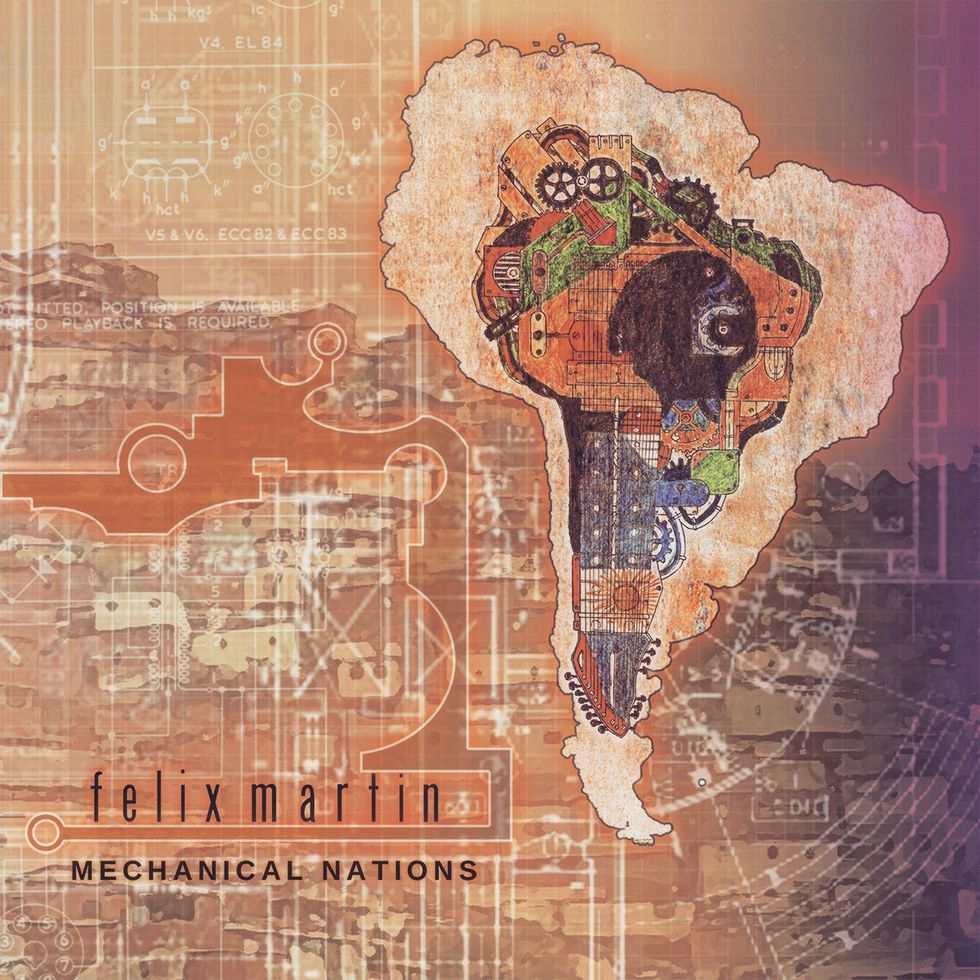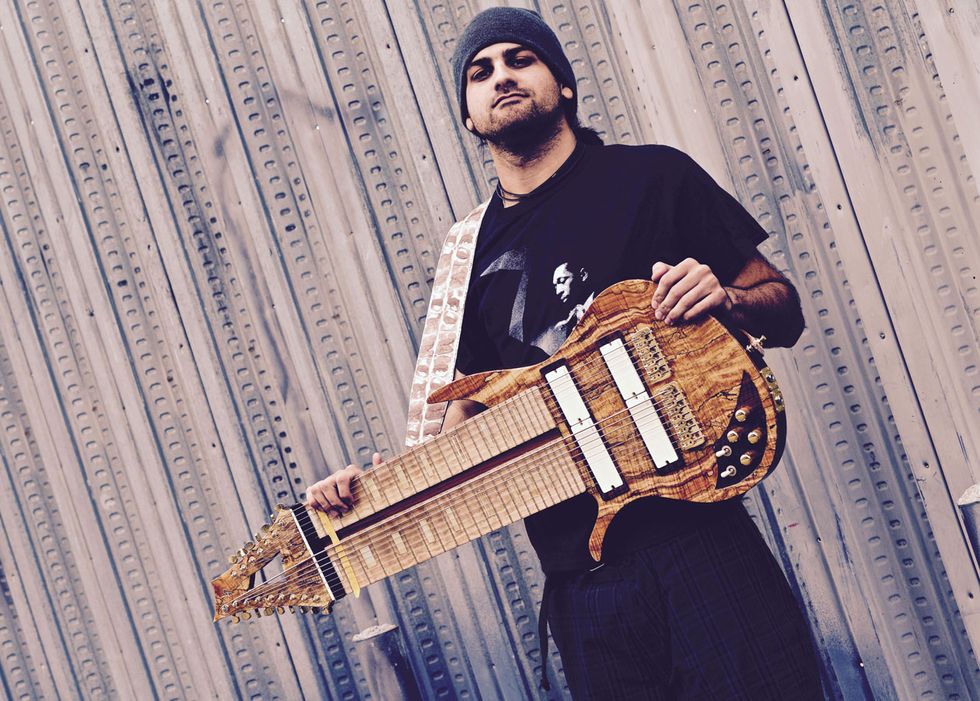If you’re unfamiliar with Venezuelan guitarist Felix Martin, your first reaction to his technique might be, “Seriously?!”
Martin, who is left-handed, plays an upside-down, extended-range/multiple-string, doubleneck guitar. But his guitar is no ordinary upside-down, extended range/multiple-string doubleneck: The two necks are conjoined—although the fretboards are separate—and create an almost contiguous 16-string playing surface.
On top of that, Martin is a bona fide virtuoso. He plays using an eight-finger tapping style, one hand per neck, and the parts he plays are often contrapuntal, polyrhythmic, and piano-like in their harmonic richness. He insists that he doesn’t practice two-handed independence, but your ears may tell you otherwise.
This complicated style isn’t a gimmick. Martin is a diverse musical talent who graduated from Berklee College of Music, where he studied composition, orchestration, production, arranging, and transcribed music from around the globe. His genre home base is post-Dream Theater prog, but he’s fluent in multiple styles including classical, world, and jazz fusion.
On his latest album, Mechanical Nations, Martin chose to focus on that which makes him different: two-handed tapping and percussive techniques. Despite his formidable picking chops, he stopped using a plectrum three years ago. He also doesn’t currently use distortion, a traditional amp, or stompboxes—instead deriving his tones from a Fractal Axe FX II, which he runs direct to the board both live and in the studio.
And still, his new album is heavy. The music’s rhythmic intensity and powerful percussive element help maintain his metal credentials. Using clean tones means he can showcase his music’s complexity without sacrificing aggressiveness (or muddying up the mix).
Left-handed, conjoined, doubleneck guitars aren’t commonplace, obviously, and Martin’s instruments are custom built (see the accompanying sidebar to learn about his latest collaborator, Polish luthier Skervesen Guitars).
We spoke with Martin as he was about to embark on a 10-city tour with Middle Eastern fusion masters Consider the Source. Martin discussed his innovative approach, building his unique instruments, his deep musical roots, and why—despite what looks like compatible technique—he doesn’t play a Chapman Stick.
What is the genesis of your approach?
I started when I was 12 or 13 years old. For me as a beginner, it was very hard to play fingerstyle guitar. For some reason, tapping was a lot more natural. I started playing these classical tunes, pop songs, and everything using tapping instead of classical fingerstyle. Then I started playing with two guitars at the same time.
I feel if you have one hand on each guitar, there’s more freedom. You can play chords in one hand and then melodies in the other hand and your hands won’t overlap. I spent a lot of time when I was in high school playing like that—taking a regular Ibanez 6-string guitar and a Stratocaster, and playing them at the same time.
Did you take lessons at the beginning?
I grew up in a small town in Venezuela, so there weren’t teachers there. Nobody played electric guitar; just three guys in town. It was hard for me to learn guitar but, at the same time, it made me creative, because I had to discover everything for myself. Fingerstyle was extremely hard for me. It didn’t make sense for me at all. That’s when I started tapping, basically. Tapping was more natural. It made more sense—everything was more organized.
Did you ever try a regular doubleneck guitar?
No. I’m left-handed, so to find a left-handed guitar like that is impossible. My guitars are different from a traditional doubleneck.
Your music incorporates so many different influences. What do you listen to?
I grew up listening to everything, from classical, to jazz, to metal. I was into world music a lot when I was growing up, too. When I was at Berklee, at the Berklee library, I would take music from each country and transcribe it.

Felix Martin’s latest album, Mechanical Nations, was recorded with his trio, which consists of bassist Kilian Duarte and drummer Victor A. Carracedo. Martin prefers no layering or backing tracks on his studio recordings.
Music from Greece, Venezuela, Brazil, Colombia, and all of Europe—world music was a big passion I had. When you want to be a professional musician and have music as a career, you want to learn every style. That’s what I did for many years. Even traditional jazz and death metal … everything.
So, you can play everything from Charlie Parker to Napalm Death, and everything in between?
I could play it, but I’m not a jazz musician. I’m mainly a rock and metal guitar player. There’s a video of me playing Charlie Parker—and it’s cool and it sounds good—but I’m not a jazz player.
What did you do to develop your two-handed independence? It looks like your hands do very different things.
Mainly, a lot of practice. I actually don’t practice independence that much; I just do stuff. If I have a musical idea or a solo thing that I’m working on, I try to mix it with both hands. It just happens. One thing I’ve noticed: When you’re playing two things at the same time, you’re not thinking “twice.” Some people think, “You’ve got two brains.” That doesn’t exist. You have one brain. The two things you’re doing, you’re doing as one thing. You’re thinking one thing, but you’re doing it with both hands.
You hear it as one idea.
It’s just one idea. When I’m playing these complicated lines with both hands, I’m playing it as a regular guitar player. I’m thinking just a single thing in my brain. It’s easier than people think.
Felix Martin’s first doubleneck guitars were built by Canadian luthier JP Laplante. Martin still plays his custom Laplante models, including this doubleneck with a 9-string and 7-string configuration. Photo by Mary Escalona
Which is harder: complicated independent parts or a unison line on both necks?
It depends on what you’re playing, but I think they’re the same. At this point, you’ve just got to play them well. That’s the hardest part: Make whatever your playing sounds good. Obviously, if you want to play a Bach fugue, that’s really hard. I’m transcribing a Beethoven piece and it’s really challenging on guitar. It’s a piano piece, not a guitar piece. It’s so fast and the arpeggios are with just one hand and then the other hand is doing something else.
You play a lot of cool polyrhythms between your two hands. Talk about learning how to do that.
I was really into them when I was a teenager and when I was at Berklee. I used to listen a lot to Dream Theater and jazz fusion groups like the Bad Plus. Nowadays, I’m more into focusing on trying to discover new sounds on the guitar rather than music-theory-related things. I’m really influenced by drummers, too. For the polyrhythms, I would listen to Virgil Donati [Allan Holdsworth, Planet X] and Marco Minnemann [the Aristocrats, Joe Satriani], and then Mike Mangini and Mike Portnoy [Dream Theater]. Nowadays, I’m more influenced by the gospel chops guys like Tony Royster Jr. and Thomas Pridgen [the Mars Volta]. I really like drummers and I get a lot of inspiration from them.
You recorded with Marco Minnemann, too?
Yeah, that was long ago. That was fun.
In addition to tapping, you also use many different picking techniques—slap guitar, and things like that.
Yeah, but I don’t do that anymore. I haven’t played with a pick since three years ago. That was the last time I touched a pick.
Really?
For the new album and the new set list for the live shows, I’m not using a pick at all. On the older material, sometimes I use a pick. I used a pick for shred lines and power chords, but nowadays I will play them with my index finger. I developed a technique where I use my index finger as a pick.
It was painful at the beginning, but I can play lead lines and power chords with the index finger. I play tapping all the time. It bothers me a lot to play tapping and then to grab the pick. If you’re playing live, you’ve got to put it in your mouth or somewhere else. So, I decided not to play with a pick anymore.
In addition to playing sans pick, there’s also no distortion on the new album. Why is that?
It’s not that I didn’t want to use distortion; it’s more that I wanted to focus on what makes me different. It was a challenge to write a guitar-based album where you’re not using distortion, playing power chords, or soloing and playing lead lines.
There are a lot of people already doing that, so I focused on tapping—the chords I do with tapping, the percussive techniques, and then the whole scale of things that I do with the tapping and also the slapping. I wanted to do something different that sounds really different. It was a big challenge and for the next album I think it’s probably going to be the same. I’m going to focus on pushing myself a little further, pushing the technique more and more, and make it better.
You’re able to get some heavy sounds, which is pretty surprising.
That was another challenge. We play shows with progressive metal bands, and we belong to the metal community. I was like, “Man, I’m going to do this tapping, but I have to make it sound heavy.” The first song, the first groove on the album, I’m just tapping, but I’m playing hard and focused. I’m playing two chords at the same time, like two minor chords, but I’m playing them really fast and really hard. It sounds pretty heavy and I’m not using any distortion. That was the idea; to do something heavy, but that sounds different.

Guitars
Skervesen Goliath double 8-string
JP Laplante assorted custom models
Amps and Effects
Fractal Axe FX II
Keith McMillen SoftStep 2 MIDI Controller
Strings and Picks
Ernie Ball 8-String sets with a .074 for the 8th string and a .064-.068 for the 7th string
What is the role of the bass player in your band and why don’t you just play those parts yourself on your 8-string guitars?
Well, first, my guitars are just guitars. I don’t have bass strings on them. But mainly, I don’t like to do the bass parts on my guitar—that’s why we have a bass player. I want to find different sounds using both hands for the guitar. The bass player is mainly playing the roots, just like in any band, and taking care of the low end.
Do you enjoy getting harmonically adventurous, pushing parameters, and exploring dissonance?
I don’t experiment with dissonance much these days. I’m experimenting with chords and with tensions. I have this thing where I can play a chord and then I can play the same shape on the other neck and get all the tensions. For example, you can play a regular Cm7 [on one neck] and an AbMaj7 [on the other]. It’s the regular shapes of those chords, but it’s another voicing. Nowadays, I play more in the key than outside the key, but I have a lot of older stuff online. I was a big fan of diminished scales, where I would harmonize the whole thing and all the melodies were on the diminished scale.
Do you improvise or is most of your music worked out?
It’s pretty worked out, though live I improvise a lot. I think more like a drummer. I play fills in between. I don’t always play the same thing live. I change things. I think it’s more fun for me. I don’t know if it’s more fun for the audience, but I feel like having fun onstage.
Berklee-educated Felix Martin can play anything from Charlie Parker to Dream Theater to Bach or Beethoven, but his preferred genre is progressive metal and rock. Photo by Mary Escalona
Who built your guitars and helped you with the concept?
I’ve got many guitars and they were built by a few luthiers, but the one who built the most is JP Laplante. He is a luthier in Canada. He helped me with the concept and to design it better, too. The lower horn was a big problem and then the weight—he helped me a lot in the beginning. Nowadays, I play a Skervesen—they are a Polish company—but I still play the guitars JP made me, too.
Were you in Venezuela when you built the first one or were you already at Berklee?
I was at Berklee. I was kind of building on it in Venezuela, because I had the idea already. I did a few experiments in Venezuela, but not officially. I was a teenager and I didn’t have access to luthiers and all that.
Do you vary your pickup choices and do you keep both necks activated all the time?
I mostly use the middle position—which is weird for guitar players—on both fretboards. Sometimes I use the bridge pickup for distortion when playing lead lines. I don’t play many lead lines nowadays, but when I play lead lines, like with a pick, I use the bridge. For some stuff, I use the neck, but 95 percent of the time it’s the middle. And both fretboards are always on. I’m always using them.
Do your guitars have two outputs?
The guitars have two outputs, but I always use both outputs on mono. Right now, I’m using the Axe FX II.
“Mono” meaning both outputs go into the same amp and it’s the same tone on both necks?
Yeah. I can do different stuff on both necks, but I prefer to play mono, as one guitar.
Your guitars have different string combinations, like seven and seven, or eight and six. what are you using now?
Eight and eight is my main setup right now. The other ones are cool, but eight and eight fits my style a little more. I can write more stuff and I have more freedom.
Are both necks tuned the same way?
Yeah, all the time. I just use regular tuning. The lowest string is Gb/F#. It’s F#–B–E–A–D–G–B–E.
I saw a picture of you with an 11-string. Do you use that?
That was just joking, man. If you see me with a different guitar, like an 11-string or a 9-string or some weird bass, I’m joking with that.
Have you ever experimented with a Chapman Stick?
Yeah, but they’re not a guitar. I’m a guitarist. It’s a whole different thing. It’s not even a bass. I can’t play a Chapman Stick. You would be surprised, because my technique is similar, but the Stick is just a total different thing. I like it. I’m friends with a lot of Chapman Stick players. I just can’t play it.
Your Skervesen has fan frets. What do you like about them?
They’re just a different instrument. I don’t want to say it’s better or worse; it’s just the feeling of the instrument is different. Technically, you get a better sound on the lower strings because you get more tension because of the fan frets, but for me I see it more as a different tool for writing. I write different, because the instrument feels different. My next guitar probably won’t have fan frets. Not because I don’t like it—I just need different tools for writing.
What are you using to mute the strings?
I don’t play open strings that much. To play tapping, without getting too much noise, I use Velcro.
In the studio, do you record everything live?
Everything live. I don’t like to do double-tracking or layers of guitars. I like to play one thing and that’s it. The new album is just like a live trio. I don’t like to use backing tracks or strings in the background. I just like the sound of a trio.
Do you sit in the same room together when you record?
No, we record everything separated. That’s the way we record it, but the album feels live because we aren’t doing layers of guitars.
Do you plug your Axe FX II into the board or do you mike a set of speakers?
It depends, but mostly the Axe FX just going into the board.
Do you do the same thing live?
I plug the Axe FX into the PA all the time. I don’t use amplifiers anymore. Someday, I want to start using amps again, but not any time soon. When you use an amplifier, you get a little distortion and the clean tone won’t be as clean as a direct sound. I do a lot of clean tapping, so it sounds better if I go direct. It’s cleaner for me.
Watch Felix Martin in action on his custom Skervesen 16-string doubleneck at NAMM 2017. Martin doesn’t currently use pedals in his regular rig, but this live clip from the Jim Dunlop booth is a good example of his incredible tapping technique.
Felix Martin’s green, headless, double 8-string guitar was built by Skervesen Guitars in Poland. The guitar is called “the Goliath,” and features fanned frets, which Martin says help him write differently. Photo by Mary Escalona
Sidebar headline: Strength in Numbers
Felix Martin’s left-handed, doubleneck, conjoined guitars aren’t something you just walk into a store and buy. He must seek out daredevil luthiers, convince them he isn’t crazy, and work with them to craft instruments that fit his needs.Martin’s first instruments were built by Canadian builder JP Laplante. Laplante was instrumental in refining Martin’s original concept and built many of his guitars—including his 7+7-, 9+7-, and 8+6-string configurations.
Martin’s most recent collaboration, however, is with Skervesen Guitars, a small shop based near Gdańsk, Poland. Skervesen built the green, headless, double 8-string beast called the Goliath that Martin is using on his current tour and on Mechanical Nations.
“Everything was a bit different because of his unusual playing technique,” says Skervesen company spokesman Maciek Horaczko. “The main thing was shaping both the upper and lower horns so Felix can access both the upper neck and also play easily in the sitting position.”
Building the necks also proved to be a challenge. “Shaping the profiles of two necks, which are connected together, was one of the biggest problems,” Horaczko says. “It’s not obvious, but when you look at the back of the guitar, you can see the necks are not parallel. We had to recalculate the placement of the frets so that the guitar is playable and that all the notes are in place.” Each neck is seven pieces of wood—a combination of rosewood, maple, and ebony—bound together to form a 15-piece doubleneck. Each neck also sports a truss rod plus additional carbon rods to compensate for the extra tension. “The tension of so many strings is enormous,” Horaczko says. The fretboards are maple.
Skervesen also took pains to craft an instrument that was not only light, but wasn’t top-heavy. “We went with a headless construction,” Horaczko says. “When you have 16 tuners, no matter how small they are, the number 16 makes it heavy. We also used lightweight pieces of wood. The body is swamp ash, which is lightweight and has a nice sound.” The top green piece is made from poplar burl.
The biggest challenge, though, was testing the final product. “Once we finished the guitar, it was such a crazy and unusual custom guitar that there was no one who could try it,” Horaczko says. “It is also left-handed. I’m left-handed, but I really couldn’t play anything that made sense.”
Martin’s guitar is a one-of-a-kind instrument, though you can order one, too. “It costs about €5,500, which is still less than two 8-string guitars,” Horaczko says.














![Rig Rundown: Russian Circles’ Mike Sullivan [2025]](https://www.premierguitar.com/media-library/youtube.jpg?id=62303631&width=1245&height=700&quality=70&coordinates=0%2C0%2C0%2C0)



![Rig Rundown: AFI [2025]](https://www.premierguitar.com/media-library/youtube.jpg?id=62064741&width=1245&height=700&quality=70&coordinates=0%2C0%2C0%2C0)












 Shop Scott's Rig
Shop Scott's Rig







 Zach loves his Sovtek Mig 60 head, which he plays through a cab he built himself at a pipe-organ shop in Denver. Every glue joint is lined with thin leather for maximum air tightness, and it’s stocked with Celestion G12M Greenback speakers.
Zach loves his Sovtek Mig 60 head, which he plays through a cab he built himself at a pipe-organ shop in Denver. Every glue joint is lined with thin leather for maximum air tightness, and it’s stocked with Celestion G12M Greenback speakers.












![Devon Eisenbarger [Katy Perry] Rig Rundown](https://www.premierguitar.com/media-library/youtube.jpg?id=61774583&width=1245&height=700&quality=70&coordinates=0%2C0%2C0%2C0)






